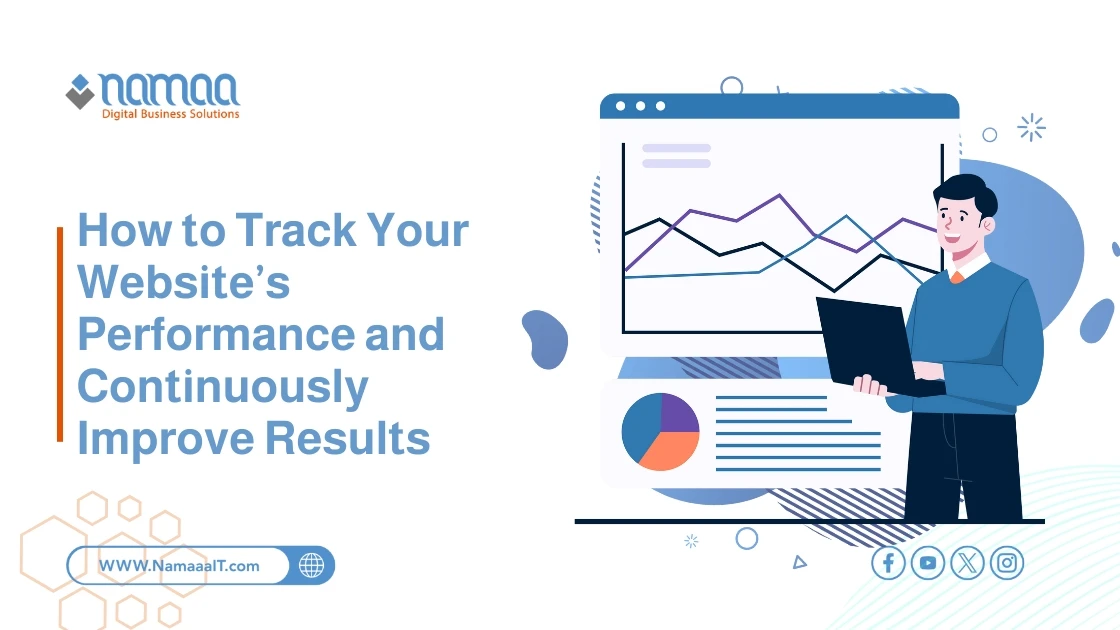Owning a website is no longer just a branding tool — it has become a vital asset for growth, engagement, and achieving business objectives. However, launching the site is only the beginning. The real challenge lies in consistently monitoring its performance and working to improve its results.
In 2025, tools are more advanced, data is richer, and keeping up with trends requires a clear, informed strategy. This article is your comprehensive guide to effectively tracking your website’s performance and implementing sustainable improvements.
Why Monitoring Your Website's Performance Is Crucial
Before diving into analytics, you need to define your website’s primary goals. Is it to increase sales? Generate leads? Build brand awareness? Or provide customer support? Setting clear KPIs (Key Performance Indicators) is the first step to effective tracking.
In 2025, performance monitoring is not a luxury — it's a necessity to stay competitive. Understanding your site’s performance allows you to:
- Make Data-Driven Decisions: No more guesswork — data helps you pinpoint what’s working and what needs adjusting.
- Enhance User Experience (UX): Understanding visitor behavior helps you design a better, more intuitive journey.
- Improve ROI: Direct your time, effort, and budget toward high-impact strategies.
- Adapt to Change: Stay ahead of algorithm updates and shifting user behaviors.
- Spot Strengths and Weaknesses: Leverage opportunities and fix issues before they grow.
Leveraging Google Analytics 4 (GA4) to Understand User Behavior
Google Analytics 4 (GA4) is the new gold standard for tracking user data. It moves away from session-based tracking (as in Universal Analytics) to event-based tracking, giving you a more accurate view of cross-platform behavior.
Key features and best practices:
- Modern Metrics: Focus on Engagement Rate, Active Users, and Engagement Time instead of outdated Bounce Rate.
- Custom Event Tracking: Set up specific tracking for important actions like button clicks, video views, form submissions, and downloads.
- Explorations: Use Path Exploration and Funnel Exploration to create custom reports and understand user journeys.
- AI-Driven Insights: GA4’s AI can automatically detect anomalies, trends, and suggest improvements.
- Audience Insights: Analyze demographics, interests, and traffic sources to tailor your content and campaigns.
SEO Performance Monitoring for Strong Organic Visibility
- Ranking high on Google is still crucial for sustainable, qualified traffic. SEO tracking in 2025 should focus on:
- Keyword Performance: Use tools like Google Search Console, Ahrefs, or SEMrush to monitor rankings, impressions, and CTR.
- Technical SEO: Ensure your site is crawlable and indexed. Check robots.txt, sitemap.xml, and address crawl errors or broken links.
- Page Experience: Prioritize Core Web Vitals, mobile responsiveness, HTTPS, and avoid intrusive interstitials.
- Content Quality & E-E-A-T: Focus on Experience, Expertise, Authoritativeness, and Trustworthiness. Your content must be original, useful, and aligned with user intent.
- Backlinks: Quality backlinks from authoritative sites still matter. Build relationships and earn links naturally.
Measuring and Improving User Experience (UX)
- UX is how users feel while interacting with your site. A good experience increases time-on-site, interaction, and conversions.
- Behavior Analysis: Use tools like Hotjar or Microsoft Clarity for heatmaps, mouse movement, scroll depth, and session recordings.
- Navigation Clarity: Ensure menus are intuitive. Analyze navigation paths with GA4 to fix friction points.
- Effective CTAs: Are your calls to action clear, visible, and compelling? Run A/B tests to optimize them.
- Accessibility: Use readable fonts, strong contrast, and proper headings. Meet global accessibility standards (WCAG).
- User Feedback: Collect direct input through surveys and feedback forms to spot UX issues quickly.
read more: Top 10 Features Your Company Website Must Have
Optimizing Load Speed and Technical Performance for 2025
- Website speed is critical — not just for SEO, but for user retention.
- Core Web Vitals (CWV): Focus on:
- LCP (Largest Contentful Paint): Time to load the largest visible element.
- INP (Interaction to Next Paint): Replaces FID in March 2024 — measures responsiveness to interactions.
- CLS (Cumulative Layout Shift): Measures layout stability.
- Image Optimization: Use modern formats like WebP or AVIF, compress images, and enable lazy loading.
- Minify CSS/JS: Remove unused code and defer non-essential JavaScript.
- Use a CDN: Distribute content globally for faster access.
- Browser Caching: Allow returning visitors to load your site faster.
Content Performance Analysis: What’s Working & What’s Not
- Content is king — but only if it resonates. Use GA4 to measure:
- Key Metrics: Page Views, Average Engagement Time, Scroll Depth.
- Top vs. Underperforming Content: Identify what brings traffic and converts — and what needs rework.
- Align Content to the Customer Journey: Ensure you have content for every stage — Awareness, Consideration, Decision, Loyalty.
- Keyword Alignment: Use GSC to see which terms drive visits. Match content with real search intent.
- Refresh Old Content: Update outdated articles or repurpose them as videos or infographics.
Accurately Track Conversions and Goals
- A conversion is any meaningful action — purchases, form fills, newsletter signups, downloads.
- Set Up Conversion Tracking in GA4: Configure key actions as "Conversions" to measure success.
- Analyze Conversion Funnels: Identify drop-off points and fix friction in the process.
- Assign Conversion Value: Add monetary value to track ROI more accurately.
- Attribution Models: Use GA4’s Data-Driven Attribution to discover which channels drive real results.
- Conversion Rate Tracking: Monitor over time and across segments to spot trends.
Advanced Tools & AI for Analytics and Prediction
- In 2025, AI and machine learning will play a bigger role in web analytics:
- Analytics Platforms: Try Adobe Analytics or Mixpanel for advanced capabilities.
- Data Visualization: Use Google Looker Studio or Tableau to create dynamic dashboards.
- AI-Powered SEO Tools: Platforms like SurferSEO and Frase.io analyze competitors and optimize your content strategy.
- Predictive Analytics: GA4 already offers predictive metrics (e.g., purchase probability). These will expand further.
- A/B Testing Tools: Use Optimizely, VWO, or others for testing design variations.
Summary
✅By 2025, GA4 is your go-to platform for tracking user behavior, focusing on Engagement Rate and Event Tracking, with advanced Exploration features.
✅Page Experience & Speed are critical: CWV metrics like INP (which replaced FID in March 2024) require under 2.5s LCP and quick responsiveness.
✅Content E-E-A-T & precise conversion tracking using GA4’s data-driven models can boost ROI by 15–25% with proper optimization.
✅AI-powered tools will help you forecast user behavior, discover trends, and improve SEO/content performance — cutting manual analysis time by up to 30%.
✅Adopt a PDCA culture (Plan-Do-Check-Act) with recurring performance reviews and A/B testing for continuous growth of 10–20% or more annually.









